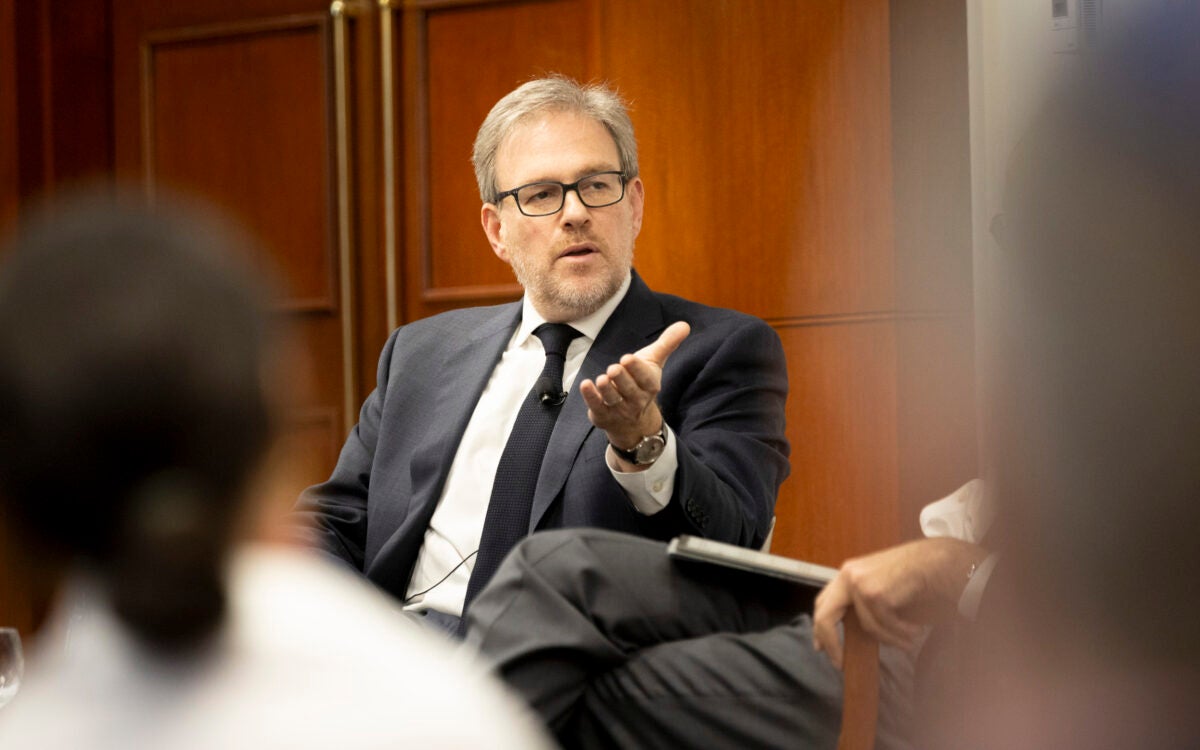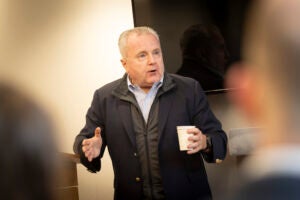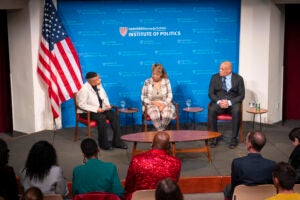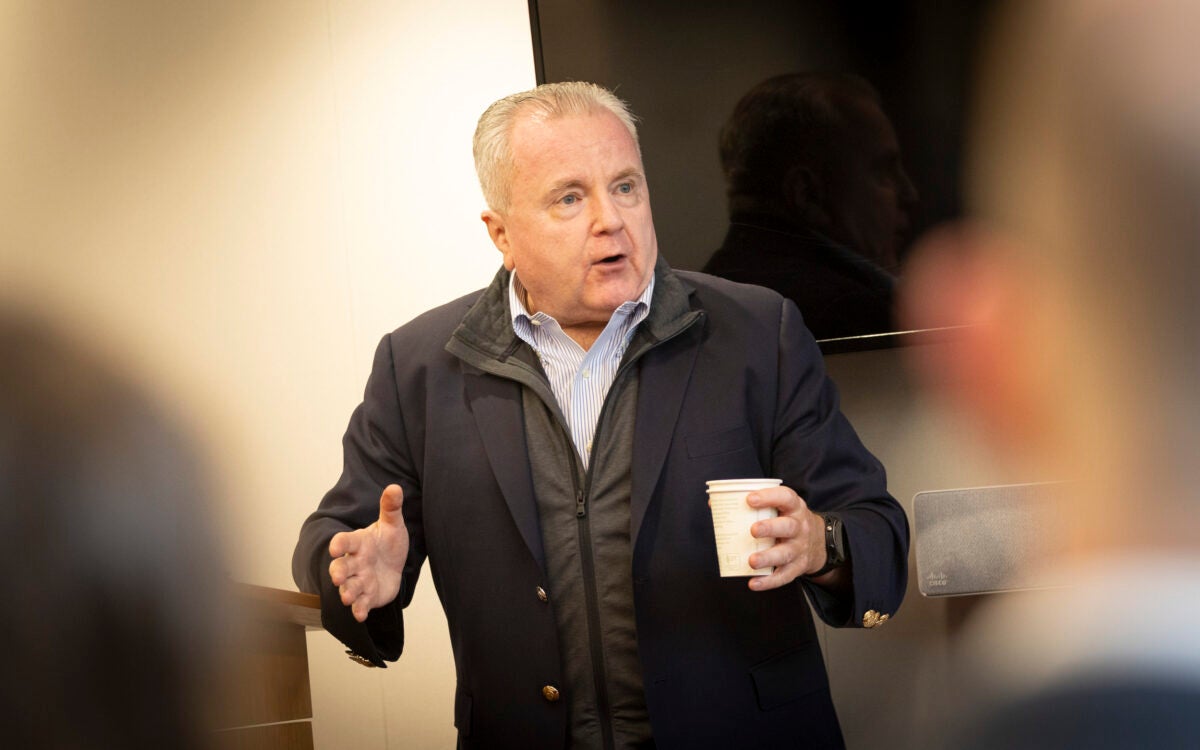Activating ‘mindshare’
Mounting a movement to redefine teaching at Harvard, and beyond
To teach is to take a risk.
Before a traditional lecture, some faculty psych themselves up just as professional athletes do; others rely on grounding methods such as placing the lectern just so, or having a favorite kind of chalk at hand.
After all, the odds are inevitably skewed. It could be an instructor looking out at a few dozen students, or in the case of some of Harvard College’s more popular courses like “Justice” or “CS50,” one up against nearly 1,000.
Imagine, then, the reaction of even the most seasoned and confident teachers when they are encouraged to shake things up, rethink their tried-and-true format, and engage in new and unfamiliar methods.
But a national faculty survey produced by Higher Education Research Institute and released on Nov. 13 implies that change may be afoot, as lecturers, often called sages-on-the-stage, increasingly adopt student-centered and team-based teaching practices. Such recalibrations of the pedagogical universe are happening at Harvard, too.
For evidence, one only needs to look at a recent workshop held by the Derek Bok Center for Teaching and Learning in early November. “Active Learning: From Evaluation to Practice” explored ways to create a safe environment for faculty to experiment. The meeting drew together faculty and pedagogy experts from 30 institutions in greater New England, ranging from community colleges like Bunker Hill to small liberal arts schools like Williams and Wellesley to larger public and private research institutions, including Harvard, Yale, Boston University, and University of Massachusetts, Boston.
“While not new, active learning, or activity-based learning, has been on the rise as the traditional ‘sage on the stage’ of classroom learning has come under scrutiny in the ‘Google it’ age,” said co-organizer Dustin Tingley.
The emphasis of active and activity-based learning, or ABL, is hands-on and minds-on engagement, such as in-class quizzes, team problem-solving, or student performances, and could even include related outside-of-class fieldwork or internships. While hybrid or blended learning, which uses online materials to replace or supplement standard lectures, has been the cause célèbre du jour, it is rightly part of the broader, evolving active learning tradition.
Tingley, Paul Sack Associate Professor of Political Economy in Harvard’s Department of Political Science and Director of the Program on Experience Based Learning in the Social Sciences, said the event aimed to be catalytic, but also practical, with the notion of “creating more on-ramps for instructors to implement newer teaching practices.”
“By studying and sharing what kinds of active learning techniques work, we can use evidence to influence how individuals and institutions think about teaching and allow for greater transparency for students.”
Tingley’s fellow organizer, Robert Lue, who oversees a number of related efforts on innovative pedagogy and has a role as faculty director for both the Bok Center and HarvardX, said that this is a time when the pedagogical stars have aligned.
“We are in a particular moment of opportunity to support learning more effectively,” said Lue, professor of the practice of molecular and cellular biology. “It has seemed like an uphill climb even though the research has long been there and there is a remarkable evidence base. The so-called MOOC revolution, or disruption dialogue, and the increased focus around standards happening at the government level, has been the proverbial shot across the bow of the traditional model of teaching.”
Divided into two sessions (adoption and assessment), the daylong event was orchestrated with particular help from Virginia Maurer, associate director of the Bok Center. Taking cues from active learning methods, she asked the panelists and participants to share past successes as well as develop new solutions to promote active learning — on the spot.
Professor Ping-Ann Addo of UMass Boston had all heads nodding when she said, “The main challenge with adopting new teaching methods is based upon faculty fears about having less control and less time to cover everything they are used to.”
In short, they ask, “What do I have to give up?” in terms of content to introduce non-lecture-based activities in the classroom. For example, if a hands-on activity is used to teach acceleration due to gravity, will the standard chalkboard mathematical explanations suffer?
Janet Rankin, MIT’s senior director for teaching initiatives, flipped things around by unpacking audience expectations, as “faculty and students have different visions of what teaching looks like. Students, while often thought to be digital natives or attracted by innovation, might resist new teaching techniques or group-based learning if expectations, for example, about grades, are not clear. [Several years ago] MIT students in an introductory physics course that was flipped” — students had to watch video lectures in advance and come to class ready to experiment ― “initially revolted.”
In a similar way, faculty with promotions or tenure ahead might be more apt to think creatively if they knew that such experiments were protected, or evaluation-free. Addo recommended that one way to obtain buy-in was to change the assessment method, having faculty members who are trying out experimental teaching reviewed by other faculty in a collaborative, non-judgmental manner.
“Transparency and expectation-setting are vital for success,” said Lue, in the same way that users of a new software program or a video game beta version know they are getting a sneak peak of something that still needs to be refined. They themselves become kind of co-creators by improving the final product.
To that end, Rankin discussed the power of simple exit surveys or “exit tickets,” where at the end of class students write down what they liked or didn’t like about a given aspect of a class, or note a concept or idea that they did not fully understand.
In addition to taking the temperature during the run of an innovative course, Aatish Bhatia, associate director of engineering education at Princeton University and author of the popular science blog Empirical Zeal, suggested letting students know the facts in advance.
“If there is compelling evidence that a particular type of active learning led to better grades or satisfaction in a course, put that right in the description or have the faculty member announce that on day one,” he said.
Tingley also noted that motivation is not always tied to the perceived academic Holy Grail: good grades. Instead of A’s, students might be seeking career or life advice.
“Our job as teachers is not just to facilitate the role of students but having students generate some of the learning outcomes,” he explained. “In my case, I learned that what many of my political science students wanted out of my class was to know what public service looked like if they were to pursue a career. So I try [to] place opportunities for this alongside more traditional academic content.”
Understanding the internal drivers, for both teachers and learners, not only helps signal what might be working in class, but could influence future content and methods and make it easier to develop new or revise existing courses. In short, up-front investment in novel or evidence-based methods could offer a win-win for both audiences, in particular to faculty.
Addo put it this way: “While teaching can be nourishing, it can also be draining” when it is not tied to moving a needle or a means to self-fulfillment. To win hearts and minds and encourage new experiments that might be risky or time-intensive “demands a return to the core motivation of why faculty wanted to teach in the first place,” she said.
All teachers, she said, want to get to the point “where they are not just covering the material but they are uncovering the material.”
The second part of the workshop zeroed in on maintaining magic in the classroom and preserving the often ineffable student-teacher relationship while bringing data and more rigorous assessment techniques to bear.
From the student perspective, Gillian Pierce, director of learning assessment in the Provost’s Office at Boston University, talked about the importance of giving students authentic assessment tasks that allow them to demonstrate their skills by doing rather than by knowing. “This involves identifying up-front the complex skills we want to measure,” she said.
Moreover, performance-based assessments (such as, “Did you build the race car you set out to build?”) allow students to formulate problems, integrate information, test solutions, and assess their own progress along the way. This provides the basis for measuring both process and product rather than looking at assessment only in terms of the summative function.
Jennifer Frederick, executive director, Center for Teaching and Learning at Yale University, echoed the need to have a visible path for learning (like building that race car); otherwise assessment can seem decoupled or after-the-fact, instead of part of the instructional process.
Linda Grisham, director of the Center for Teaching and Learning at Massachusetts Bay Community College, echoed the importance of assessment during instruction to monitor learning progress, detect errors, and provide feedback to students. Grisham noted that this could be as simple as a series of low-stakes quizzes, such as those she uses in her classes to find out how students are doing.
The panelists ended with a discussion about the importance of building communities of practice as a way to get faculty to adopt assessment strategies. This should occur both within universities and across institutions so that there are more opportunities for shared best practices — like the very meeting they were attending ― and for a greater focus on transparency and integration of efforts to promote new forms of learning.
Harvard is an ideal case study, not only serving as a convener, but also engaged in bringing together like-minded local efforts. The ABL meeting, while organized by the Bok Center, had support from the Harvard Initiative for Learning and Teaching (HILT) and the Institute of Quantitative Social Science, and wide participation from the HarvardX team. Such collaboration has been taking root both organically and formally through the recently formed Office of the Vice Provost for Advances in Learning (VPAL).
For example, in the past year, a comprehensive study by Bok’s Jenny Bergeron, director of educational research and assessment, explored best practices in four blended courses at the College that utilized online learning resources developed by HarvardX. One of the major reveals was the level of challenge faculty often face in figuring out how to integrate active learning components, as even short video content was not necessarily plug-and-play.
With that in mind, over the past summer Bok set up the Blended Learning Support Team (nicknamed BLST or “Blast”), comprised of campus experts in instructional design, educational research and technology, and assessment methods.
Designed as a flexible web of support, the BLST team, led by Terry Aladjem, Bok’s director for special initiatives, is already working with faculty from several current courses, such as “China” and “The Ancient Greek Hero.”
“Many faculty are eager to take advantage of new forms of online content and other active learning elements,” said Aladjem. “It turns out, however, that integrating student-centered learning practices is not just flipping a switch, but a team effort that requires planning. We aim to be the team in the pits to help the driver, or the faculty member in this case, get up and running smoothly and to be able to fix things along the way.”
Via BLST, discussions are happening with more than a dozen faculty members teaching in areas ranging from economics to chemistry to English literature. Active components being explored include more periodic student feedback to allow instructional and content adjustments on the fly, and real-time in-class electronic responses to quizzes to gauge comprehension.
Mentioned frequently at the conference, one of the technologies spurring interest in highly engaged learning was developed right here at Harvard. Learning Catalytics ― the brainchild Eric Mazur, a professor of physics and pioneer of peer assessment; Gary King, head of the Institute for Quantitative Social Science; and Brian Lukoff, a former postdoc at the School of Engineering and Applied Sciences — offers real-time assessment responses using existing mobile technologies like phones and tablets.
The tool, recently acquired by education publishing giant Pearson, is being considered for use in ECON 1723, “Capitol Markets.” One of the most common uses of the app is to pair classmates who have different answers to a question (e.g., “What is the difference between net and gross earnings?”) and have them hash out their reasoning during class. The underlying notion is simple, but powerful: Students often learn best from one another, with the instructor serving more as a coach or “guide on the side.” The days of being called up to the chalkboard to solve the question may be nearing an end.
Of course, active learning opportunities can go beyond students clicking through questions or huddling up to solve for X — and even the physical limitations of the classroom. Gene Corbin, assistant dean of Harvard College for Public Service, has greeted the rise of active and online learning at the College with enthusiasm.
“In my definition, active learning could mean finding ways to have students take knowledge right into the field. Imagine integrating local service opportunities that match with a course’s learning objectives,” he said.
A fan of efforts such as the FIELD program at HBS, which offers students immersion opportunities at sites around the world, Corbin is interested in finding practical ways to mimic that experience in a way that makes sense for full-time undergraduates, without having to fly students all over the world or interrupt their studies.
“I envision using technology to bring the world in or mount a collaborative group project with experts or other students, on, say, responding to something like the Ebola crisis,” he added. “All happening right on our own campus.”
Introducing what Harvard President Drew Faust called the “bidirectionality of learning” — simultaneously pushing knowledge out and bringing knowledge in — is, in fact, already happening, in large part through open online learning efforts. HarvardX courses such as “CopyrightX,” “Justice,” and “Innovating in Health Care” have created global student teams, run parallel satellite courses at locations all around the world, and even integrated live feeds into a classroom.
With such a plethora of active learning practices, technologies, and flexible content, the real barrier for Harvard and other faculty may be the tyranny of choice. How can faculty know what exists? Or get tips on what has worked well? A response and potential solution rounded out the workshop.
Enter ABLConnect (http://ablconnect.harvard.edu), a compendium website of active learning suggestions, research, tutorials, and video tutorials. Tingley and Harvard graduate student Leslie Finger spearheaded the creation of the site, intended as an open archive for sharing and archiving active learning practices.
Supported by a partnership of higher education institutions, Tingley envisions pulling together an advocacy group that could steer broader educational policies or inform the public about the ways institutions are upping their teaching game. Showing rather than telling, Tingley explained, may be the best way to change the infrastructure of both institutions and governing bodies.
He reminded the participants that the site, like the workshop, was not about Harvard, but open to all. Harvard, he said, can help convene and elevate a dynamic conversation about learning and encourage transformation.
Lue built on that idea, explaining that a change in definition and perception about teaching is now within reach.
“The notion of redefining how we see ourselves as educators or as teachers is long overdue. Our identity is not simply as lecturers, or someone who holds this skill set. We are instead scholars, explorers, creators, and discoverers. And we are not alone in our classrooms, but we are a community.”




